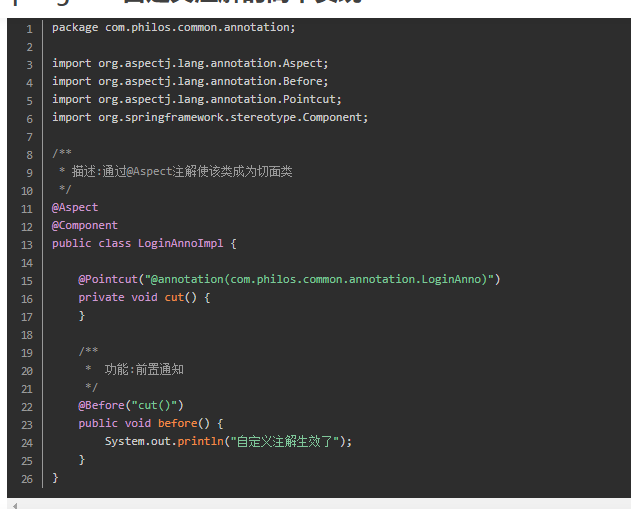springboot 怎样自己定注解
spring 自定义注解已经是常用操作 我们来复习一下操作步骤
第一步
引入jar
<groupId>org.springframework.boot</groupId>
<artifactId>spring-boot-starter-aop</artifactId>
第二步
创建注解接口
定义参数
@Documented
@Retention(RUNTIME)
@Target(METHOD) public @interface LoginAnno { String value(); }
@interface是用来自定义JAVA Annotation的语法,
@interface是用来自定义注注解类型的
@interface是用来自定义注注解类型的
@Documented –注解是否将包含在JavaDoc中
@Retention –什么时候使用该注解
@Target –注解用于什么地方
@Inherited – 是否允许子类继承该注解
第三步
创建解析注解类 包括注解功能类
定义切点,并对切点做一些增强操作:前置增强、环绕增强、后置增强等等,切点的定义我们可以在一个空方法体的方法上使用@Pointcut注解

这里 @pointcut 定义切点 名字为cut
然后定义了具体方法 具体方法 因为 切点叫cut 所以 @before 后面要变成 ‘cut’
@Pointcut()里面定义的是切点表达式,切点表达式有很多,上面例子代码中的是注解表达式
这个注解表示何时把注解植入进spring
execution(方法修饰符 返回类型 方法全限定名 参数) 匹配指定的方法
@Pointcut("execution(* com.tcb.controller.SDProductController.showproductDetail(..))")
@annotation() 类或者方法 表示 这个注解类或者方法都是切点 即织入程序的点
切点 即 在什么时间切入
一般有
@before @after @around @afterretund等
JoinPoint对象封装了SpringAop中切面方法的信息,在切面方法中添加JoinPoint参数,就可以获取到封装了该方法信息的JoinPoint对象.
获取代理方法的对象和参数 并添加包装
ProceedingJoinPoint 实际应用中用到
public Object Interceptor(ProceedingJoinPoint joinPoint){
retmsg = joinPoint.proceed(); 获取方法名
System.out.println("通知之结束 +retmsg+" + retmsg);
result = joinPoint.proceed(); 程序继续执行
return result;
}
通俗一点,
JoinPoint就是在程序执行过程中明确的点,提供访问当前被拦截方法的信息,而ProceedingJoinPoint除了JoinPoint能够获徖的信息外,还可以通过proceed()方法来继续执行被拦截的方法,常用于@Around修饰的AOP拦截。




【推荐】国内首个AI IDE,深度理解中文开发场景,立即下载体验Trae
【推荐】编程新体验,更懂你的AI,立即体验豆包MarsCode编程助手
【推荐】抖音旗下AI助手豆包,你的智能百科全书,全免费不限次数
【推荐】轻量又高性能的 SSH 工具 IShell:AI 加持,快人一步
· TypeScript + Deepseek 打造卜卦网站:技术与玄学的结合
· 阿里巴巴 QwQ-32B真的超越了 DeepSeek R-1吗?
· 【译】Visual Studio 中新的强大生产力特性
· 10年+ .NET Coder 心语 ── 封装的思维:从隐藏、稳定开始理解其本质意义
· 【设计模式】告别冗长if-else语句:使用策略模式优化代码结构